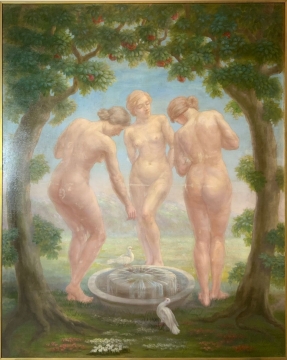Vital and Elsie Handali-Verstraete bequeathed their collection to the King Baudouin Foundation. The collection comprises works by important artists including Jane Graverol, James Ensor, René Magritte, Léon Spilliaert and Constant Montald. The couple decided to make this generous donation to the King Baudouin Foundation in order for it to be shared with as many people as possible. The works will be entrusted to Mu.ZEE in Ostend, the Ixelles Museum (Brussels), the Verviers Museum and the Charleroi Fine Arts Museum.
A very eclectic collection
There are three parts to the Handali-Verstraete collection. The first is an impressive collection of 19th and 20th century works, ranging from traditional still lifes to complex Surrealist compositions by Belgian artists such as Jane Graverol, James Ensor, René Magritte and Léon Spilliaert. The second part is of older works, with original realisations dating from the 17th to 19th centuries, including religious representations and hunting scenes, and copies of famous paintings. The third part comprises various religious and spiritual works of art, such as Russian icons, statues of the Virgin Mary and a number of Asian objects such as the bronze statues of the goddess Kannon and Buddha.
Constant Montald’s Les Trois Graces
One of the works in this amazing collection is Les Trois Grâces (The Three Graces), a monumental painting signed by Constant Montald, in which the artist depicts the classic iconography of the Three Graces. Montald took inspiration for this from a Pompei fresco with a contrast between the women seen from the front and back. The scene takes place around a fountain in an idyllic forest, which is also part of classical iconography, even if the women do not have their arms intertwined. Tree trunks embrace the centre of the scene in an almost playful yet extremely decorative manner. The theme of the Three Graces has been an integral part of art history, from Raphael and Rubens to Permeke. Social themes to which Constant Montald refers in his previous works, such as the survival of the fittest in the knights’ battle that we see in the 1885 La Lutte humaine (the Human Struggle), here give way to an idealised representation that emphasises beauty and serenity, two aspects that are specific to the Graces who are considered as muses and inspirers of creativity. Because of its style and theme, this undated work can be associated with another of Constant Montald’s paintings, Les cinq Grâces (the Five Graces, 1931, inv. 10607, at the Fine Arts Museum of Brussels).
